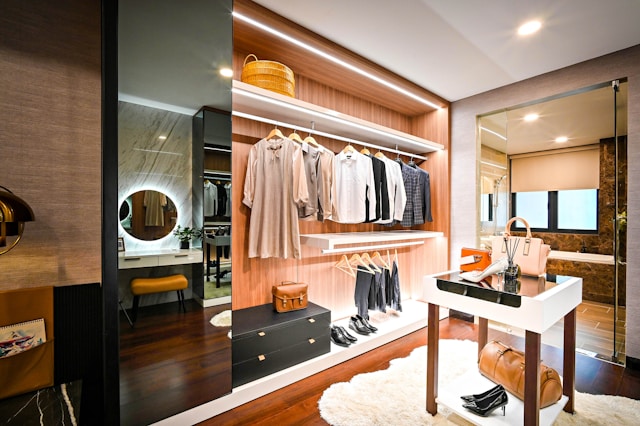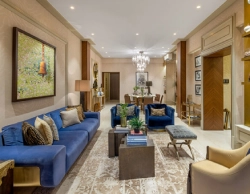Wardrobe Decluttering: How to Build a Stylish and Functional Closet

A nice and organized closet does not just happen; it requires some thoughtful preparation and sporadic upkeep. Our closets can become overflowing with goods due to years of garment accumulation, shifting fashion trends, and changes in our lifestyles. Keeping your closet neat and orderly improves your sense of style, saves time, and makes choosing dresses for daily wear easier. This article talks about how to design a closet that expresses your individuality while being functional and user-friendly.
Step 1: Evaluate Your Present Wardrobe
Make a detailed inventory of everything you own before you start cleaning out. Your go-to favorites, pieces you seldom wear, and items that no longer suit your style are all revealed when you look through your wardrobe. The important actions to take are as follows:
- Empty your Closet: Take everything out of your wardrobe, including clothing, accessories, and shoes. This forces you to look at what you have in plain sight while doing the work, preventing you from missing anything. You can see your clothes from a different angle in a clean environment.
- Sort Into Categories: Sort your belongings into dresses, jackets, shirts, pants, shoes, and accessories. Cleaning up and being methodical so nothing is missed is made easier by this.
- Evaluate Every Item: Verify that each item makes you happy, fits your style, and was worn recently. Take off any clothing that you do not wear, that does not fit, or that is in disarray unless you plan to fix it.
- Set Up a Sorting Area: Designate a space where you may rapidly arrange your belongings. This makes it easier to tidy up and maintain organization without allowing things to become too chaotic.
Step 2: Declutter with Purpose
Cleaning out your belongings might be difficult, but it is a lot easier if you are orderly and considerate. To organize your wardrobe and help you make wiser decisions, apply the Four-Pile Method:
- Keep: Items that fit you well, are in good shape, complement your style, and are used daily. These should be garments that you want to wear and that you can mix and match to create different looks.
- Donate/Sell: Give someone else unused, in good condition clothing. This gives them a fresh start and helps someone in need. Selling products might be an excellent way to earn extra cash.
- Repair/Alter: Items of clothing that need to be fixed or altered to be wearable and functional. You can get well-fitting clothing by spending a little money on little repairs.
- Discard: Items that cannot be repaired, dirt, or tears. Having things around leads to clutter and keeps your closet from being neat and stylish. Whenever feasible, recycle cloth rather than throwing it away.
Follow this procedure to the letter. Generally speaking, keeping clothing "just in case" leads to excessive clutter. Follow Marie Kondo's advice to simplify your decision-making process and only keep items that make you happy or are useful. Eliminating your belongings gives you the chance to update your look and maintain only the items you love and wear.
Step 3: Define Your Style
For both fashion and functionality, your closet should reflect your hobbies, body type, and sense of style. If you are unsure of your style, follow these steps to find out:
- Get Inspired: To find looks and ensembles you like, browse fashion blogs, Pinterest, Instagram, and magazines. Take note of the common fashions in the clothing you like. This will allow you to consistently get a comparable appearance.
- Locate Important Items: Track down what types of clothes you like best. Which do you prefer—simple clothing, trendy styles, or a combination of all? Understanding your preferences could assist you in making your next buy.
- Create a Color Palette: It is simpler to put together attractive ensembles when you have a unified color scheme for your clothes. Pick that bright color that appears on your skin and lots of neutral colors.
- Consider Your Lifestyle: Bear in mind how your week, weekends, social life, and workout schedule would flow seamlessly together. In this way, your closet would serve its purpose well, enabling you to get ready.
Your overall style will guide what is most appropriate, both from a requirement perspective and a visual one.
Step 4: Build a Capsule Wardrobe
High-quality, durable, and versatile clothing that can be mixed and matched to create endless outfits is what composes a capsule wardrobe. A closet equipped with compatible clothes makes it possible to combine pieces and create outfits for dozens of occasions. Here’s a guide for creating your own:
- Start with the Basics: Favorite dresses, black pants, white tee, classic jacket, jeans, and other go-to pieces. Embrace your basic pieces. When you put effort into styling each piece, these can all feel ‘in season’ when paired together.
- Select Versatile Items: Skin tone face “on” casual formal attire plenty of combinations featuring summer dresses. While the nighttime look is fun and varied, the same-toned dress can be worn during the daytime.
- Add Statement Pieces: Eye-Catching Items: Elevate your overall style with a few unique, go-to pieces that showcase your personality. These wardrobe statement pieces amplify your visual appeal with their beauty.
- Put Quality Above Quantity: As long as it can endure, a stronger item will get you closer to the dream because it uses less frequently worn parts. There are fewer but better-quality products.
- Minimize Excess Items: Steer clear of an excessive amount of clothing options to facilitate decision-making and streamline your wardrobe for better comprehension. It is easy to put on clothes with a simple style.
Step 5: Organize Your Closet for Functionality
Organize your closet so that you can easily locate and utilize your clothing and other belongings.
- Make use of Matching Hangers: Space-saving, thin, non-slip hangers make clothing appear neat and coordinated. Maintaining the same kind of hangers gives your closet a polished appearance.
- Sort by Category & Color: To make things easy to find and visually appealing, group comparable items together and arrange them according to color. Choosing clothes is quick and simple using this system.
- Make the Most of Storage Space: For convenience and neatness, use shelves, drawer organizers, and hanging bags to arrange shoes, accessories, and seasonal goods. Options for storage aid in maintaining organization and avoiding chaos.
- Store Out-of-Season Clothing: To keep closets organized and make room for new clothing, store out-of-season clothing in boxes with labels. You can keep your wardrobe fresh and intriguing by switching it up with the seasons.
- Label Storage Containers: Bins and boxes that are labeled make it easier to find stuff quickly, which saves time and effort when looking for certain products.
Step 6: Maintain Your Wardrobe
Cleaning your area is something you should perform regularly rather than just once. Regularly inspecting your clothing keeps it in good condition and functional.
- Adhere to the One-In, One-Out Rule: Get rid of an old item when you purchase a new one. This prevents accumulation and maintains equilibrium.
- Seasonal Reviews: Every few months, examine your wardrobe. If necessary, make adjustments to maintain order and efficiency.
- Appropriate Clothes Maintenance: Clean, store, and handle your clothing with care. They look better and live longer as a result.
- Avoid Impulse Purchases: Give your purchases due thought. This ensures that you have chosen your items and keep your closet organized.
- Make a Budget for your Wardrobe: Select quality over quantity. It is better to have a stylish and eco-friendly selection than too many.
Conclusion
More than just clothing, a neat closet conveys your sense of style, self-assurance, and way of life. To improve your appearance and make daily outfit selections easier, declutter, identify your style, and arrange your closet. Keep your wardrobe organized, prioritize quality over quantity, and periodically check your clothing to improve both style and utility. A well-stocked wardrobe increases confidence, saves time and space, and makes getting ready more enjoyable. You may create a closet that suits you by following these steps, which will make getting dressed fun and simple every day.











